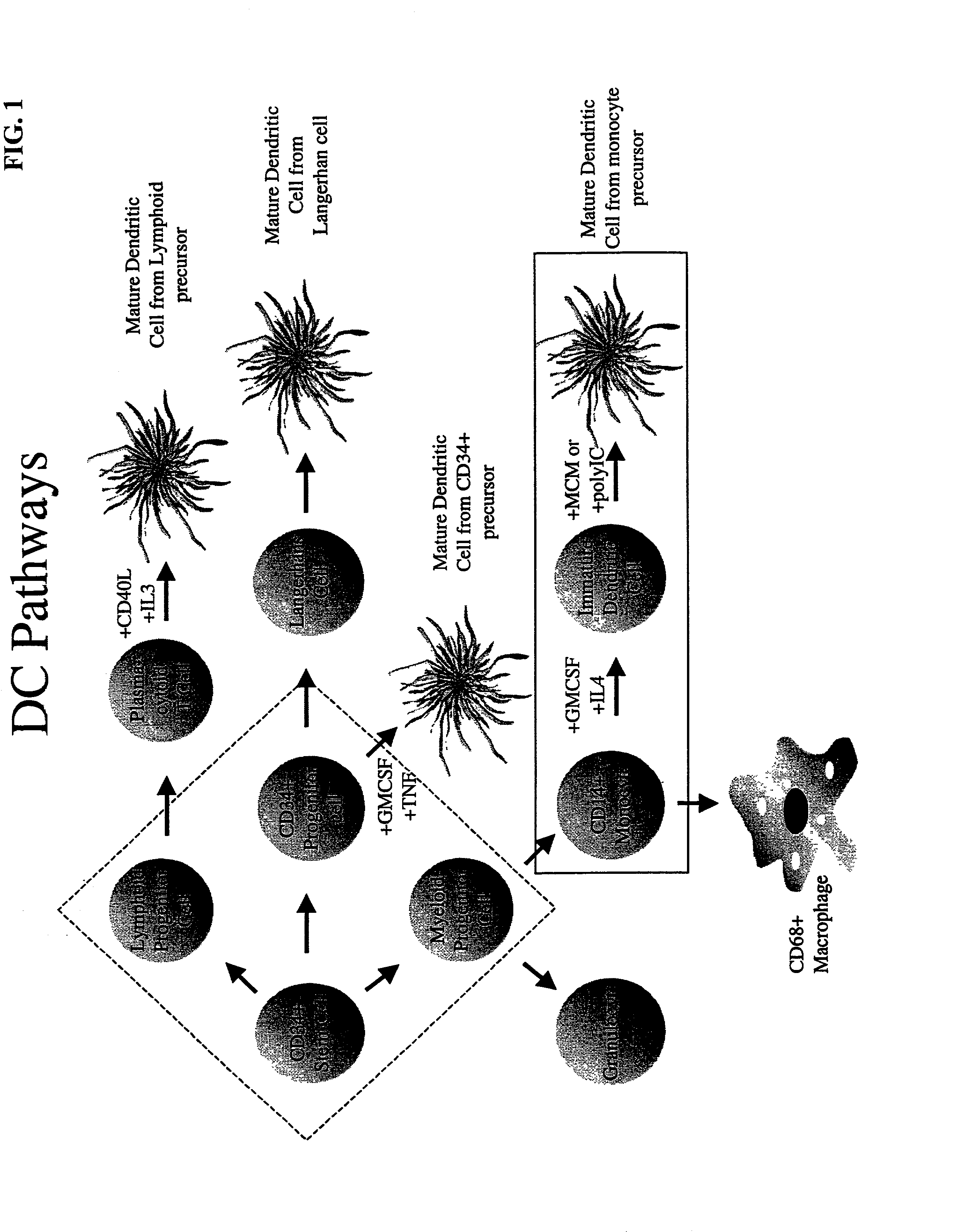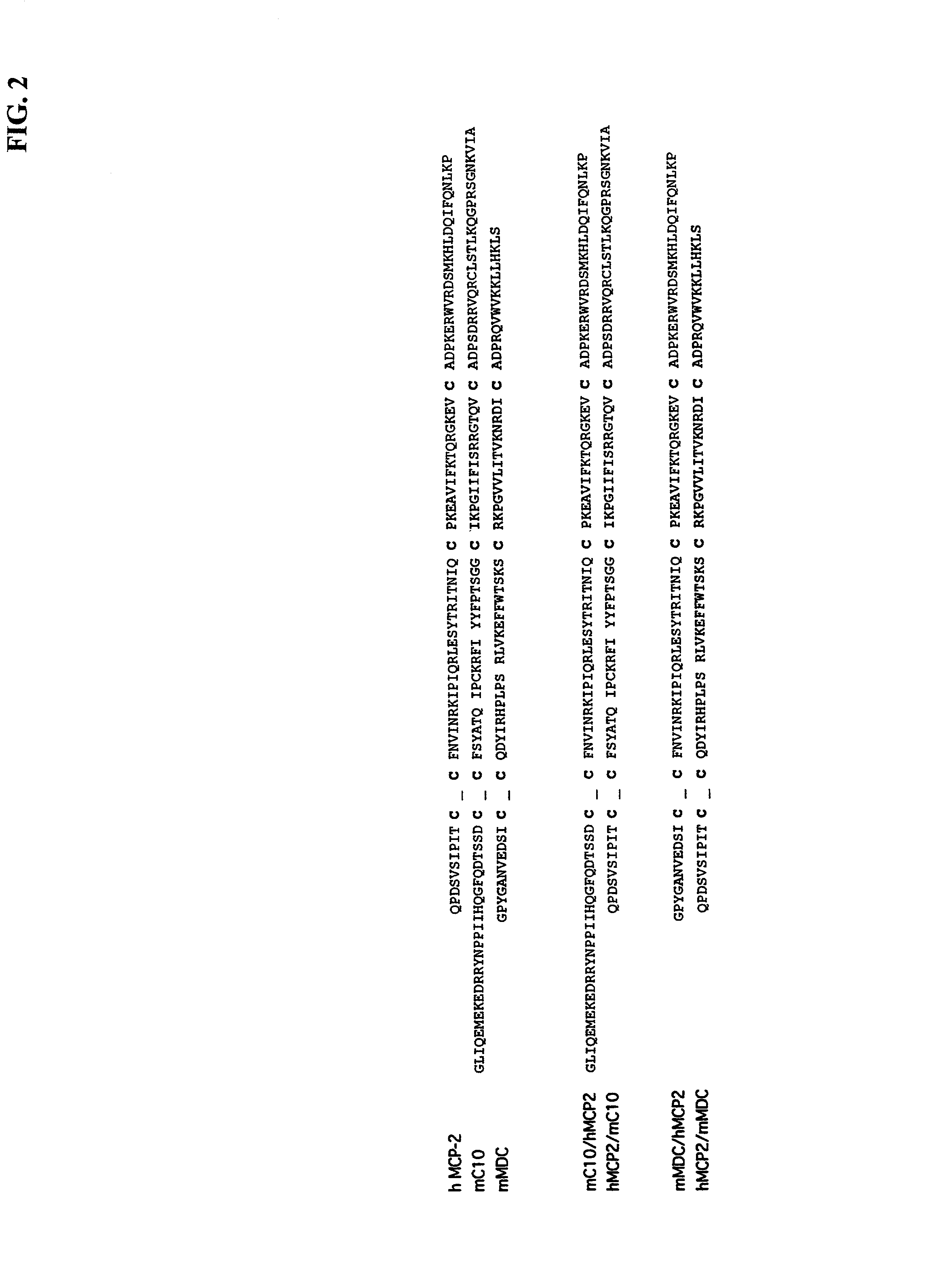Methods and compositions for inducing an immune response
a technology of immune response and composition, applied in the field of methods and compositions for inducing immune response, can solve the problems of considerable lag time between immunization and immunization, and the effectiveness of present immunization methods for all antigens
- Summary
- Abstract
- Description
- Claims
- Application Information
AI Technical Summary
Benefits of technology
Problems solved by technology
Method used
Image
Examples
example 1
Chemotaxis Assays
[0255] Chemotaxis assays are carried out using purified cells and a 96-well chemotaxis microchamber (ChemoTx.RTM., NeuroProbes, Inc, Gaithersbrug, Md.). In this assay, a porous polycarbonate filter is used to allow formation of chemoattractant concentration gradient across the filter, as well as to allow cells to migration into the filter or through into the lower well.
[0256] To perform an immature dendritic cell chemotaxis assay, 29 ul of a candidate or known APC-chemotaxin at 0, 1, 10 and 100 nM CHECK concentrations is placed in the wells of the lower chamber. The filter is placed on the top of the chamber, so that the chemoattractant solution touches the under side of the filter. Day 7 immature dendritic cells are harvested, washed once with chemotaxis buffer which contains 0.1% BSA (Sigma) in HBSS (Life Technologies), with Ca.sup.++ and Mg.sup.++), and finally resuspended in chemotaxis buffer at 5.times.10.sup.6 per ml. Twenty microliters of cells is carefully p...
example 2
Chemokine Injection Into Mice
[0257] This example describes an in vivo assay in which the ability of several chemokines to attract dendritic cells is demonstrated.
[0258] The following chemokines were obtained from R&D Systems (Minneapolis, Minn.): MCP2, MCP3, MIP1.beta., MIP3.alpha., MIP3.beta., Rantes, mMIG, mMDC, mC10, vMIP1. Each chemokine (2 ug in PBS) was injected intradermally into a different BALB / c mouse. One mouse received a control injection of PBS with no chemokine. 72 hours after injection, the mice were euthanized and the area around the injection site was excised and subjected to immunohistology. Frozen sections were stained with anti-DEC-205 antibody (available from Bio-Whittaker Molecular Applications, Rockland, Me.; Kraal et al., 1986, J. Exp. Med. 163:981), which recognizes a surface molecule specific to dendritic cells. A relative staining number on a scale of 0 to 5 were assigned to each section (0=lowest infiltration, 5=highest infiltration). Results are shown in...
example 3
Chemokine Injection Into Rhesus Monkeys
[0260] This example demonstrates that certain chemokines injected intradermally to a non-human primate elicit mononuclear infiltration to the site of injection.
[0261] Coded, sterile chemokines (2 ug in PBS) were injected intradermally (100 ul injection volume) into the upper arm of a Rhesus macaque under anasthesia. In each case, two monkeys were each given two injections of the same chemokine to two different locations (e.g. left arm versus right arm). After 72 hours one injection site was punch biopsied and separated into an edge and a center sample and both samples were prepared for immunohistology. After 96 hours the other injection site was punch biopsied and separated into an edge and a center sample and both samples were prepared for immunohistology. Each row on Table 5 represents a single animal. A section of the prepared tissue was hematoxalin and eosin stained, and mononuclear cells identified based on cellular morphology (e.g. being ...
PUM
| Property | Measurement | Unit |
|---|---|---|
| Mass | aaaaa | aaaaa |
| Mass | aaaaa | aaaaa |
| Mass | aaaaa | aaaaa |
Abstract
Description
Claims
Application Information
 Login to View More
Login to View More - R&D
- Intellectual Property
- Life Sciences
- Materials
- Tech Scout
- Unparalleled Data Quality
- Higher Quality Content
- 60% Fewer Hallucinations
Browse by: Latest US Patents, China's latest patents, Technical Efficacy Thesaurus, Application Domain, Technology Topic, Popular Technical Reports.
© 2025 PatSnap. All rights reserved.Legal|Privacy policy|Modern Slavery Act Transparency Statement|Sitemap|About US| Contact US: help@patsnap.com


